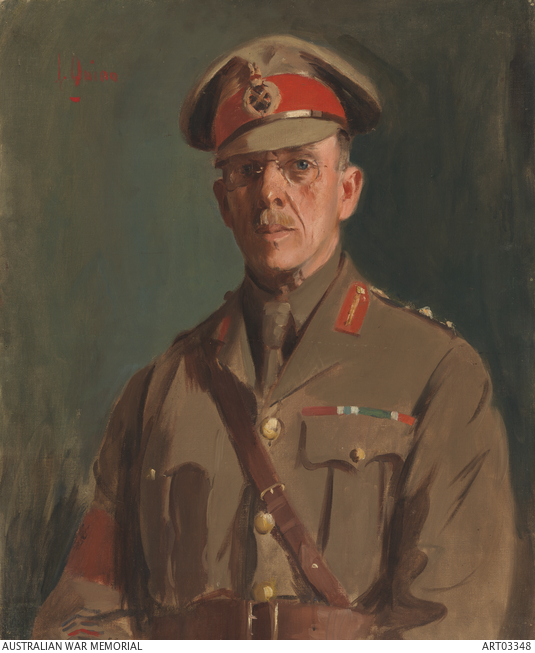| Places | |
|---|---|
| Accession Number | ART03348 |
| Collection type | Art |
| Measurement | framed: 93.9 x 81.4 cm; unframed: 76.6 x 63.6 cm |
| Object type | Painting |
| Physical description | oil on canvas |
| Maker |
Quinn, James Peter |
| Place made | France, United Kingdom: England, Greater London, London |
| Date made | 1918 |
| Conflict |
First World War, 1914-1918 |
| Copyright |
Item copyright: Copyright expired - public domain
|
Major General Sir Joseph Hobbs

Official war artist James Quinn was instructed to paint the portrait of Major General Sir Joseph Hobbs as part of an ongoing series of portraits that acknowledged senior military leaders in the Australian Imperial Forces.
Throughout his life, Major General Sir Joseph Hobbs KCMG KCB(M) CB(M) pursued dual careers: as an architect; and as a soldier. Born in England, he emigrated to Australia in 1887 and had extensive involvement with the armed forces in Western Australia, including being attached to the British Army for training in 1897 and 1913. At the outset of the First World War, Hobbs was appointed to command the 1st Divisional Artillery, serving on the Gallipoli Peninsula.
Moving on to France, Biographer AJ Hills records, ‘Hobbs was acting commander of the 1st Anzac Corps Artillery from October until December when he was given command of the 5th Division. His promotion to major general followed on 1 January 1917….In April 1918 Hobbs was largely responsible for the recapture of Villers-Bretonneux.’ In the recommendation for the Knight Commander of the Order of St Michael and St George, the following citation was provided:
Major General HOBBS has, throughout the period, rendered most distinguished service, as Commander of the 5th Australian Division, in opposing the enemy attacks between the SOMME and VILLIERS BRETONNEUX in April and May 1918, and in the series of operations from August 8th till Sept.18. including the capture of BAYONVILLERS, HARBONNIERES, FRAMERVILLE, VILLIERS CARBONNEL and PERONNE. – His Division has always been maintained in a high state of fighting efficiency and uniformly acquitted itself magnificently. – This is due to the fine organising capacity and the qualities of leadership displayed by its Commander.
Following the war, Hobbs continued his military and architectural involvement, being responsible for designing and overseeing the creation of many war memorials.
For a comprehensive biography see: A. J. Hill, 'Hobbs, Sir Joseph John Talbot (1864–1938)', Australian Dictionary of Biography, National Centre of Biography, Australian National University, http://adb.anu.edu.au/biography/hobbs-sir-joseph-john-talbot-6690/text11539, published first in hardcopy 1983, accessed online 15 August 2016.
